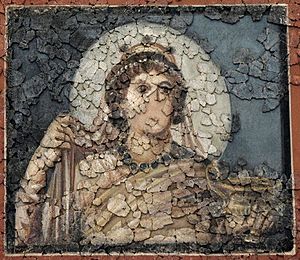Helena, mother of Constantine I facts for kids
Quick facts for kids Helena |
|||||||||
|---|---|---|---|---|---|---|---|---|---|
| Augusta | |||||||||
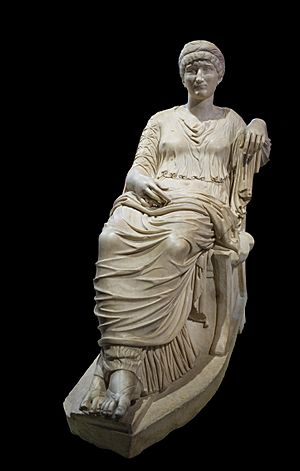
Seated statue of Helena in Musei Capitolini, Rome
|
|||||||||
| Roman empress | |||||||||
| Born | c. AD 246/48 Drepanon (later Helenopolis), Bithynia, in Asia Minor (modern-day Hersek, Altınova, Yalova, Turkey) |
||||||||
| Died | c. AD 330 Rome, Tuscania et Umbria (modern-day Italy) |
||||||||
| Burial | Mausoleum of Helena | ||||||||
| Spouse | Constantius Chlorus | ||||||||
| Issue | Constantine I | ||||||||
|
|||||||||
| Dynasty | Constantinian | ||||||||
| Religion | Nicene Christianity | ||||||||
Flavia Julia Helena Augusta (also known as Saint Helena or Helena of Constantinople) was an important Roman Empress. She was the mother of Constantine the Great, who became a famous Roman Emperor. Helena was born around AD 246-248 and lived until about AD 330.
She came from a humble background in a Greek city called Drepanon, in a region called Bithynia in Asia Minor (modern-day Turkey). This city was later renamed Helenopolis in her honor. Helena is a very important figure in the history of Christianity. Many Christian churches, including the Eastern Orthodox Church and the Catholic Church, consider her a saint.
Contents
Early Life and Family
Helena was likely from Asia Minor, which is part of modern-day Turkey. While her exact birthplace is not fully known, many believe it was Drepanon. Her son, Constantine, later renamed this city "Helenopolis" after her.
Helena was born into a simple family. Some historical writings describe her as a "stable-maid" or "inn-keeper." However, after her son became emperor, these details were often overlooked.
Helena met Constantius Chlorus, a Roman officer, and they had a son named Constantine I. Constantine was born around AD 272 in Naissus (modern-day Niš, Serbia). Later, Constantius divorced Helena to marry a woman of higher social standing.
Helena did not remarry. She lived quietly for a while but remained close to her son, Constantine. He cared for her deeply.
Helena's Rise to Power
When Constantius died in AD 306, his troops declared Constantine the new emperor. After this, Helena returned to public life in AD 312. She was given the important title of Augusta in AD 325. This title meant she was a respected and powerful woman in the Roman Empire.
According to the historian Eusebius of Caesarea, Helena became a Christian after her son became emperor. She then used her new position to support the Christian faith.
Pilgrimage and Discoveries
Constantine gave his mother, Helena, a lot of money and power to help her find important Christian relics. Between AD 326 and 328, Helena made a special religious journey to Palestine and Jerusalem.
During her trip, she helped build or improve several churches. These included the Church of the Nativity in Bethlehem, where Jesus was born, and the Church of Eleona on the Mount of Olives, where Jesus is believed to have ascended to heaven. She also ordered the building of a chapel at Saint Catherine's Monastery in Egypt.
Finding the True Cross
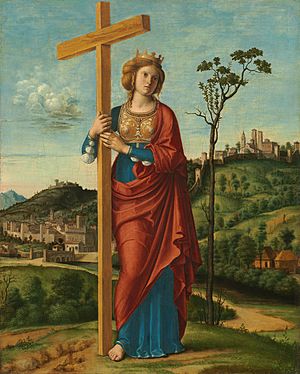
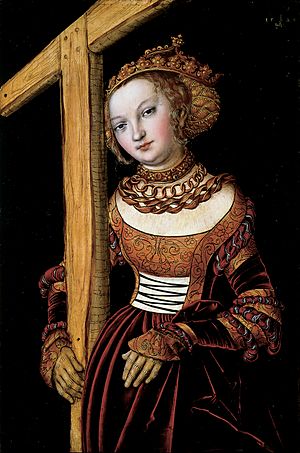
Jerusalem had been largely destroyed in AD 70. Later, Emperor Hadrian built a temple over the spot believed to be Jesus' tomb. Helena ordered this temple to be torn down.
According to an old tradition, Helena began digging at this site. She found three different crosses. To figure out which one was the True Cross (the cross Jesus was crucified on), she performed a test. A sick woman was brought to touch each cross. When she touched the third cross, she immediately got better. Helena then declared this to be the True Cross.
Constantine ordered the Church of the Holy Sepulchre to be built on this important site. This church is still a very sacred place today.
Some stories also say that Helena found the nails from the crucifixion. She supposedly had one placed in Constantine's helmet and another in his horse's bridle for protection.
Relics in Cyprus and Rome
Helena also visited Cyprus. Many relics believed to be found by her are now there. These include parts of Jesus' tunic and pieces of the Holy Cross. She is also said to have brought many cats to Cyprus to help with a snake problem!
After her journey, Helena returned to Rome around AD 327. She brought many pieces of the True Cross and other relics with her. These were kept in her palace's private chapel, which later became the Basilica of the Holy Cross in Jerusalem. You can still see these relics there today.
Death and Burial
Helena passed away around AD 330, with her son Constantine by her side. She was buried in the Mausoleum of Helena, just outside Rome. Her large stone coffin, called a sarcophagus, can be seen in the Vatican Museums today.
Honored as a Saint
| Saint Helena of Constantinople |
|
|---|---|
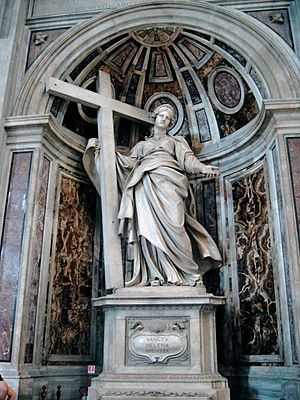
Statue of Saint Helena in St. Peter's Basilica, Rome, Italy
|
|
| Empress, Mother of Saint Constantine, Equal to the Apostles, Protector of the Holy Places | |
| Venerated in | |
| Canonized | Pre-Congregation |
| Major shrine | The shrine to Saint Helena in St. Peter's Basilica |
| Feast |
|
| Attributes | Crown Cross Nails |
| Patronage | archaeologists, converts, difficult marriages, divorced people, empresses, Saint Helena island, new discoveries, Noveleta, Cavite |
Helena is recognized as a saint by many Christian churches, including the Eastern Orthodox, Eastern and Roman Catholic churches, and Anglican Communion. She is sometimes called Helen of Constantinople.
Her feast day (a special day to remember her) is celebrated on different dates depending on the church. For example, the Eastern Orthodox Church celebrates her and her son on May 21. The Roman Catholic Church celebrates her on August 18.
In the Ethiopian Orthodox Tewahedo Church, a holiday called Meskel celebrates her discovery of the cross. This holiday is often celebrated with a large bonfire, based on a dream Helena supposedly had. The smoke from the bonfire was said to show her where the True Cross was buried.
Helena is considered the patron saint of new discoveries.
Later Stories and Traditions
In British Folklore
In Great Britain, some old legends say that Helena was a British princess. These stories claim she was the daughter of a king named Cole from Colchester. However, historians say there is no real proof for this story.
Despite this, many churches in England are named after Saint Helen. She is also the patron saint of Abingdon and Colchester. The town of Colchester even has a statue of her on its town hall tower.
Filipino Legend
In the Philippines, a special parade called Flores de Mayo honors Helena and her son Constantine. This parade celebrates their finding of the True Cross.
Helena in Modern Fiction
Helena has been featured in several modern books. She is the main character in Evelyn Waugh's 1950 novel Helena. She also appears in the fantasy novel Priestess of Avalon and Louis de Wohl's novel The Living Wood.
Relics of Saint Helena
Helena's skull is believed to be displayed in the Cathedral of Trier in Germany. Other parts of her relics are found in churches in Rome, Paris, and Hautvillers.
The church of Sant'Elena in Venice claims to have her complete body.
Images for kids
-
Helena's sarcophagus in the Museo Pio-Clementino, Vatican Museums, Rome
 In Spanish: Helena de Constantinopla para niños
In Spanish: Helena de Constantinopla para niños


